Britain's greatest natural wonders to explore in the wintertime
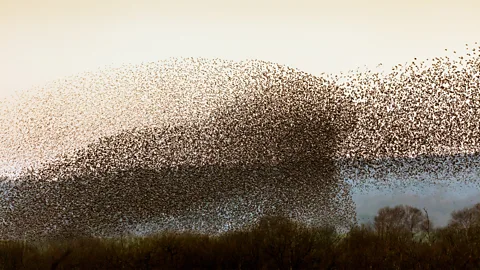 Getty Images
Getty ImagesAcross the UK, a collection of natural marvels reveal themselves at this time of year, including some of the rarest and most spectacular phenomena that the country has to offer.
For many Brits, the winter months – particularly once Christmas and New Year have passed – are all about hunkering down at home and waiting for the freeze to thaw. Across the British Isles, though, a collection of natural marvels reveals itself at this time of year, including some of the rarest and most spectacular phenomena that the country has to offer.
From ghostly optical illusions to flocks of dancing birds, these British winter wonders are enough to encourage even the most ardent homebody to get their boots on, brush up on their photography skills and brave the big chill.
Mountain hares
Animals changing their coats in the winter is a phenomenon often associated with polar species: the Arctic fox, Peary caribou and Canada's collared lemming, for instance. Less well known is that the British Isles have an animal of their own that dons a dashing white winter coat: the mountain hare.
Although it is now vanishingly rare, this is Britain's only native hare – the brown hare, much more common today, was introduced to Britain by the Romans. England's only population of mountain hares lives in the Peak District, where the animal was reintroduced in the 1800s. They can be spotted in their snow-white winter coats between November and April, bathing in the pale sunlight in areas of moorland and heather. One of their favoured haunts is Bleaklow, a mountain along the Pennine Way atmospherically scattered with the wreckage of World War Two aircraft.
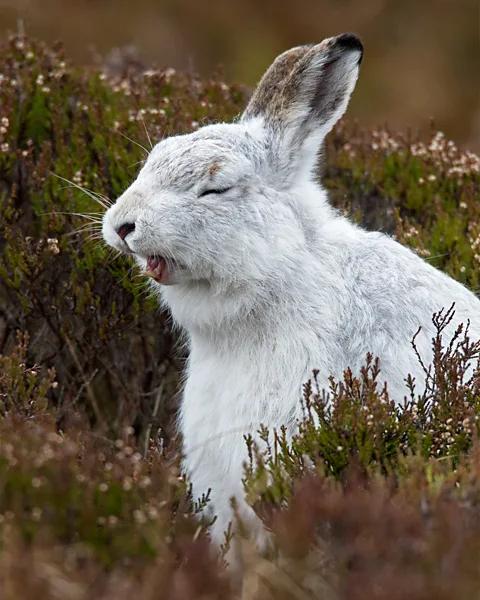 Getty Images
Getty ImagesThe largest concentration of mountain hares in the UK, though, is in the Scottish Highlands, where the animals can be spotted on sheltered slopes covered in thin snow, beneath which they dig for food. Mountain hares can be found all over the region, but a popular spot is the Monadhliath Mountains, southeast of Loch Ness. While you're there, look out for the mountain hare's avian equivalent: the ptarmigan. This plump, grouse-like animal is the only British bird that turns white in winter, and the UK's only population also lives in the Scottish Highlands.
Brocken spectres
Scotland is also one of the best places in the UK to spot another mountain phenomenon: the eerie Brocken spectre. Many a hillwalker has paused on a mountain trail and turned to admire a cloud-scattered view, only to be confronted with a huge, looming shadow figure, often with rainbow-coloured glory rings emanating from its head.
This creepy optical illusion is actually the walker's own shadow, magnified to enormous proportions. It appears when the Sun rises on one side of the walker and casts their shadow onto a blanket of cloud on the other side. As such, it is especially common during cloud inversions, when clouds gather in valleys below mountaintops, giving the impression of a soft white ocean. A light wind completes the spooky effect, making the spectre move as if it has a life of its own.
The Brocken spectre takes its name from the Brocken, a mountain in Germany where it is commonly observed, but it can be spotted in the right conditions in highland areas across the UK, from the Lake District to the Malvern Hills. The most storied spot to see it though is Ben Macdui, the highest peak in Scotland's Cairngorms Mountains and the second-highest mountain in Britain.
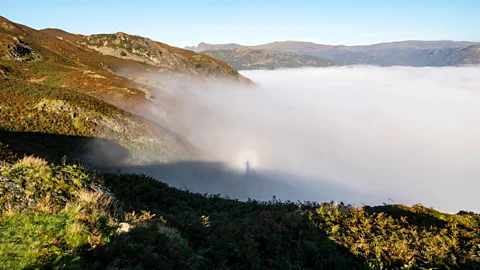 Getty Images
Getty ImagesSightings of Brocken spectres here are likely to have inspired the legend of the Big Grey Man (Am Fear Liath Mòr in Scottish Gaelic) of Ben Macdui. The Grey Man matches the description of the Brocken spectre – a tall, thin shadow figure obscured by fog – though he is accompanied by the eerie added elements of the sound of crunching gravel and a general feeling of unease.
Many people report feeling alarmed or unsettled by their experience of the Brocken spectre, and the symbolic quality of the phenomenon – its ability to terrify a person with nothing more than their own shadow – has been commented on by the likes of poet Samuel Taylor Coleridge and psychoanalyst Carl Jung.
Starling murmurations
One of the best loved phenomena in the world of birdwatching – and often described as Britain's greatest natural spectacle – is murmuration, the species-specific word given to the flocking behaviour of starlings. These small birds are very social animals, often roosting together in their thousands, and during the winter months they flock together to fly at dawn and dusk in remarkable swirling formations, like a synchronised dance troupe casting morphing silhouettes against the twilit sky.
It's thought that the flocking behaviour, much like shoaling of fish, serves the purpose of confusing predators as well as sharing warmth and communication. The name "murmuration" comes from the murmuring sound generated by the collective flap of the birds' wings, which can be impressively loud as they pass overhead. There's much that seems mysterious about murmuration, not least how the starlings do it without crashing into each other. The birds move in unison, but in incredibly complex patterns, as if they are tapped into a hive mind – but in fact, it's their incredibly quick reaction times that keep them from colliding.
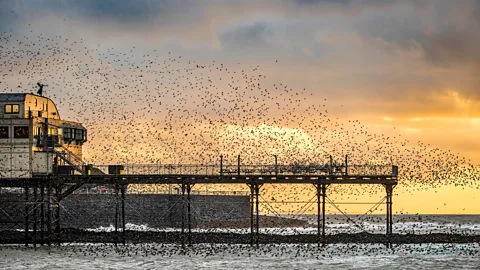 Getty Images
Getty ImagesThere's something awe-inspiring about witnessing this ancient avian dance, which takes place at sunrise and sunset across the UK between November and February. Although murmurations happen inland too, coastal areas are particular hotspots. Aberystwyth, in west Wales, sees murmurations take place over its Victorian seafront pier – a picturesque juxtaposition of human engineering and natural wonderment that is a favourite of photographers.
The dark night
Britain is a densely populated island, and really dark night skies can be hard to find in built-up areas. In fact, according to Kielder Observatory in the north-eastern English county of Northumberland, "85% of the UK population has never seen a truly dark sky or experienced the sense of wonder that a clear night filled with billions of stars can give."
Outside the cities and towns, though, true darkness can still be found. Kielder Observatory sits in the second-largest area of protected dark sky in Europe, and holds several stargazing evenings each week in the winter months. The observatory is a remarkable construction in itself: a futuristic, boxy building made from local spruce and larch trees, looking like an organic spaceship that's crash-landed amid the dark conifers of Kielder Forest.
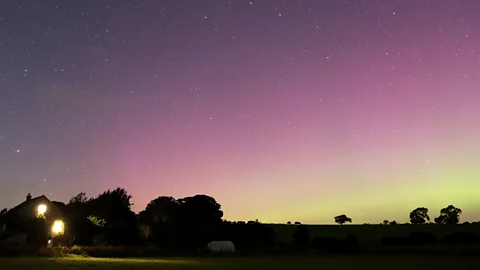 Getty Images
Getty ImagesNights at the observatory follow different themes, focusing variously on topics including the life cycles of stars, the planets of the solar system, and the night sky's great light show: the aurora. Traditionally, if Brits wanted to see the Northern Lights reliably, it meant booking a pricey holiday to the distant north: Finland, Sweden or somewhere else on the fringes of the Arctic Circle. In autumn 2024, however, the Sun entered a solar maximum, a period of heightened activity that brings the aurora out in vivid technicolour at more southerly locations than usual, including Britain. This period is expected to last for two or three years before gradually declining, and Northumberland – with its northerly latitude and dark night skies – is an excellent place to spot the Northern Lights.
Kielder is also home to one of England's only populations of red squirrel, the country's native squirrel, which is at risk of extinction thanks to the introduction of its cousin, the grey squirrel. Although red squirrels can be spotted year-round, they are very elusive, and the winter can be the best time to spot them, when their russet-coloured coats stand out more vividly against the blanket of snow.
--
If you liked this story, sign up for The Essential List newsletter – a handpicked selection of features, videos and can't-miss news, delivered to your inbox twice a week.
